Trekking on top of the world
The tour van I’ve called home for the last week comes to a stop and its passengers spill out, thankful to be able to stretch and breathe in the fresh mountain air. After an agressive schedule of traveling from village to village over the last few days, we looked forward to reaching new heights at a slower pace with the three-day, two-night “Owl Trek,” which starts in the foothills of the Himalayas outside of the town of Bumthang, Bhutan.
We weren’t quite sure what to expect, so when we pulled up to the starting point, we were a bit surprised. Nine horses, three horseman and two cooks were waiting for, as my friend said, “four very spoiled tourists.”
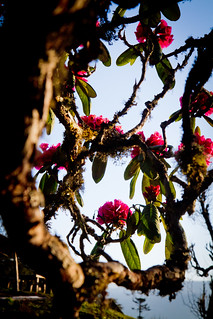 After hiking straight uphill for two hours, we were looking foward to being spoiled, at least a little. We huffed and puffed, trying to muster the strength to look up from the difficult, uneven terrain to witness the natural beauty in our midst. The trail was protected by a thick canopy of fir and juniper trees overshadowing bamboo and brightly colored rhododendrums. Wildflowers and moss blanketed the forest floor.
After hiking straight uphill for two hours, we were looking foward to being spoiled, at least a little. We huffed and puffed, trying to muster the strength to look up from the difficult, uneven terrain to witness the natural beauty in our midst. The trail was protected by a thick canopy of fir and juniper trees overshadowing bamboo and brightly colored rhododendrums. Wildflowers and moss blanketed the forest floor.
Our guide, Chungdu, announced it was time for a break and we collapsed in a sunny spot next to a broken fence, trying to avoid cow patties as we hit the ground. We all napped for a bit until the cook and assistant cook took out metal containers from an insulated carrying case and began dishing their contents onto plates they’d carried on their backs. Rice. Noodles. Fiddleheads in cheese. Chicken. It wasn’t the typical camp food I’d bring on a trek, but I wasn’t complaining.
The satisfaction of having a full belly was soon lost because we had two more hours of vertical climbing to go. “Baby steps,” Chungdu told us.
I kept reminding myself to take things slow, but we went faster than expected. Heaving myself over a thick root of a tree snaked across a steep muddy cliff on the trail, I found myself standing in an open meadow. To the left were snow-capped peaks; off to the right I caught a glimpse of Camp Shonath, our home for the night. A sign indicated we’d reach 10,000 feet in elevation.
With storm clouds threatening, I crawled into my tent just as a cold rain began to fall. When I emerged a little later, the rain had stopped and it was starting to get dark. Some of the camping crew was in the midst of a game of lawn darts. I played a bit, too, then sat in the yak-herder’s shelter nearby chatting with Karma, the horseman, via translation by Chungdu.
After a delicious meal, we were handed hot-water bottles — the best invention ever — and sent off to sleep in our tents. The temperatures dropped below freezing and I lay shivering most of the night, but the spot by my feet, where I’d tucked the bottle, remained warm.
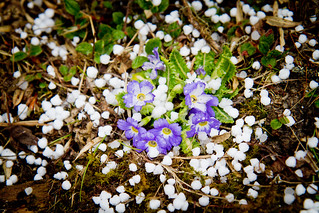 More trekking uphill awaited us in the morning, which was bright and sunny. But it didn’t stay that way. After reaching Drangela Pass and having lunch at a yak-herder’s camp, the weather started to turn. Bhutan’s highest unclimbed peak, which would have been visible at this point, was veiled by thick gray clouds. Sleet and hail began to pelt us, lightly at first. It quickly turned into a steady downpour of centimeter-thick chunks of ice that began to accumulate underfoot. Lightening and thunder surrounded us and we quickly made our descent to camp, which was located close to three mountain-perched monasteries named Zambhalha, Choedrak and Tharpaling.
More trekking uphill awaited us in the morning, which was bright and sunny. But it didn’t stay that way. After reaching Drangela Pass and having lunch at a yak-herder’s camp, the weather started to turn. Bhutan’s highest unclimbed peak, which would have been visible at this point, was veiled by thick gray clouds. Sleet and hail began to pelt us, lightly at first. It quickly turned into a steady downpour of centimeter-thick chunks of ice that began to accumulate underfoot. Lightening and thunder surrounded us and we quickly made our descent to camp, which was located close to three mountain-perched monasteries named Zambhalha, Choedrak and Tharpaling.
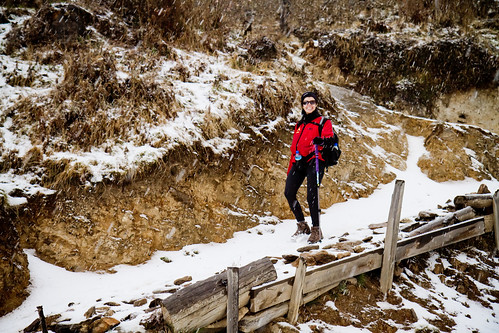 The freak snowstorm dumped almost two inches of snow and it blanketed our tents. The clothes we brought were not enough to keep us warm, and since campfires are illegal in Bhutan, the only way to warm ourselves was by holding mugs of hot water in our hands.
The freak snowstorm dumped almost two inches of snow and it blanketed our tents. The clothes we brought were not enough to keep us warm, and since campfires are illegal in Bhutan, the only way to warm ourselves was by holding mugs of hot water in our hands.
I couldn’t wait until the moment I would finally get my hot water bottle and be able to go to bed, even though I wasn’t tired. With four layers of clothing, a scarf and mittens, I crawled in my mummy-shaped sleeping bag accompanied by the hot-water bottle and fell asleep.
Footsteps crunching outside my ice-covered tent roused me from my slumber. I dreaded the cold air that was waiting to greet me. Yes, it was cold, but the sun was shining and blue skies surrounded us.
After an early breakfast, we planned to hike back up the moutainside from where we had come the day before. Taking care not to slip on the ice and mud — a dangerous combination — we slowly made our way to 12,000 feet and came to rest next to a grove of prayer flags that stood high above the first and second valleys of the Bumthang region. From this vantage point, we could finally see Gangkar Punsum, which at 24,837 feet high, is Bhutan’s highest peak and the world’s highest unclimbed peak. It is a sacred mountain and climbing it is illegal. Until now it had eluded us, but after days of waiting we finally saw it.
To spread the good luck, we made an offering to the gods where we stood at the top of the ridge. We hoisted two Peruvian finger puppets on a stick that is normally reserved for a prayer flag. We bid them goodbye and made our way back down the mountain . . . closer and closer to a warm, cozy bed.

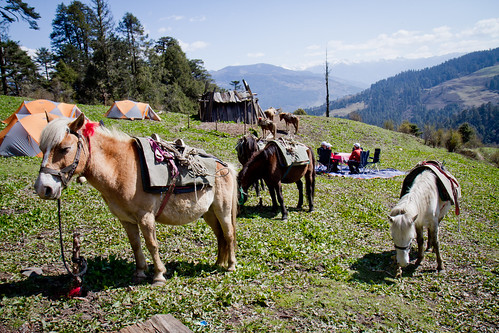
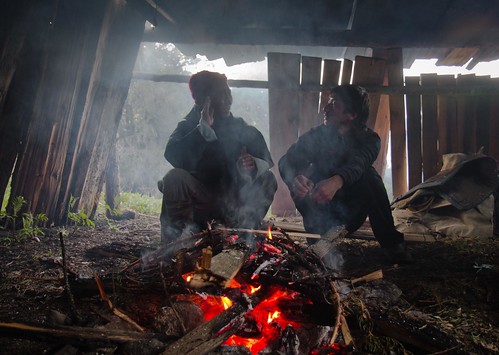
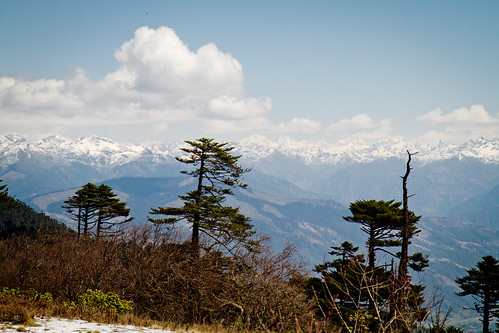

Write a Reply or Comment